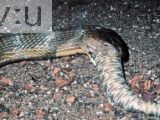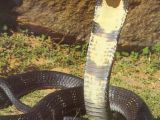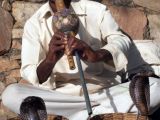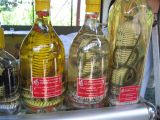1. When we think about venomous snakes, two species come first to our minds: rattlesnakes and cobras. The name "cobra" comes from Portuguese, meaning "snake" (like "culebra" in Spanish, "coluber" in Latin). The Portuguese were the first Europeans to open the marine pathway towards India around Africa and called these snakes "cobra do capello" ("hooded snake").
There are 28 species of cobra, encountered in whole Africa (16 species) and southern Asia (12 species). "The Jungle Book" made famous the Indian cobra (Naja naja), which lived in India, Ceylon and surrounding areas.
However, the most redoubtable cobra is the king cobra (Ophiophagus 1 hannah), encountered in southern Asia from India to Sulawesi and the Philippines. This is the largest venomous snake in the world: up to 5.5 m (18 ft) in length. As its scientific name suggest ("ophiophagus"= "snake eater"), its favorite dish is represented by other venomous snakes, including cobras.
2. The main particularity of the cobras is their capacity and behavior to flatten their neck into a "hood" while keeping the first half of the body raised in the air, so that their head area looks bigger when the snake is alerted. These can be done due to erectile prolonged apophyses (outgrowths) of the vertebrae, moved by powerful muscles that also stretch the skin, turning apart the scales so that on the dorsal part appears a drawing like a pair of glass (imitating two big eyes). That's why the Indian cobra is also called Spectacled cobra.
Smaller cobras are less aggressive: they first try to escape, than hiss, display their "hood", hit with the head without biting and when there's no other way they bite. King cobra is much more aggressive, attacking without much warning.
3. Ancient Egyptians venerated the cobras as protectors of the crops (indeed, they destroy rodents that can easily finish the fields if uncontrolled), a sacred creature called Uraeus, appearing as a tiara on the front of the god Ra, symbol of power together with the wings of Horus, the god of sun, turning the enemies in ash with its fire eyes.
In India, cobras are sacred animals. It is said that a cobra dilated its hood over sleeping Buddha for protecting him of the sun and as a sign of gratitude, Buddha drew those 'spectacles' on its hood. In India, the presence of a cobra in the surroundings of the household is considered a good omen. Beyond the religious aspect, it could be also a practical one: cobras exterminate mice and rats.
In pre Indo-European India, the Dravidian people venerated cobra as a totem, and in Hindu religion cobra is a symbol of fertility.
Still, 10,000 die annually in India beaten by cobras, and the snakes are attracted to human houses by rodents and heat.
Cobras feed on rodents, birds, bird chickens, rabbits and even puppies.
4. In many areas of Asia, cobra taming is practiced, an occupation that requires a lot of dexterity and quickness. The classical taming number is with the cobra hood spread lying on the basket in which the snake was accustomed to stay since the day of its capture. The story is that the tamed snake dances to the sound of the music.
In fact, the snake is not tamed at all, it is an estate of arousal, that's why the hood is spread. Its movements are rather of curiosity, as not knowing what to expect, it is ready for the attack at the slightest challenge.
The tamers know very well the behavior of the snake, which does not dance to the sound of music but follows the tamer's continuous movements of the arms and knees, while he's playing a wind instrument. In fact, cobras don't even hear the music; snakes detect just sounds with frequencies of 100-500 Hz, and only ground vibrations they perceive through the bones of the lower jaw.
5. Amongst the African species, there are the spitting cobras, like the black necked spitting cobra (Naja nigricollis) or ringed necked spitting cobras (Hemachatus hemachatus). They aim the eyes and can spit with precision to a distance of 1.8 m (6 ft), but the venom can reach 4 m (13 ft)). These cobras can launch up to 12 successive shots, at a pressure of 1.5 atmospheres, due to the instantaneous contraction of the muscles surrounding the venom glands.
The venom is dangerous only if it touches the eyes, and if it is not rapidly removed it can cause blindness.
6. Even if Rubens painted Cleopatra dying after being bitten by a viper, the legend says that the queen used for this purpose cobra venom. Cobras and their relatives (coral snakes, mamba, Australian venomous snakes, sea snakes, kraits) have neurotoxic venoms, which paralyze the muscles, and the victim dies by asphyxiation (as the breathing muscles are stopped), while vipers and rattlesnakes have hemotoxic venom that decomposes tissues, producing death accompanied by excruciating pains.
Well, in this case, Cleopatra surely would have chosen the cobras...
Not only is the venom different between the two groups, but the way it is injected also differs. Cobras have stiff front teeth with groves, while vipers have mobile channeled fangs, which while resting are sheathed inside the mouth (that's why they can be also very large).
Thus, cobras are less effective than vipers and their relatives because of the injection mechanism (grooved instead of much more effective syringe like fangs) and shorter fangs.
7. I prefer calling wine what comes from grapes, and not the infamous snake wine, an alcoholic beverage found in China and Southeast Asia countries.
The snakes, preferably cobras (and more specifically king cobras) are used to have the snake poison dissolved in the liquor. Still, the venoms, which are proteins, are inactivated by ethanol.
There are two varieties. A large venomous snake can be put into a glass jar of rice wine, often with many smaller snakes, turtles, insects, or birds, and left to ferment for months. Snake blood wine is produced by mixing the snake blood and bile with rice wine or grain alcohol. The snake meat, liver, and skin can be cooked to accompany the drink. This wine is believed to cure all kinds of conditions, from farsightedness to hair loss, and helps increase the sexual performance. Of course, that's nonsense.
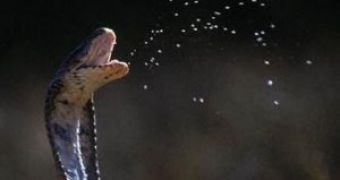
 14 DAY TRIAL //
14 DAY TRIAL // 
